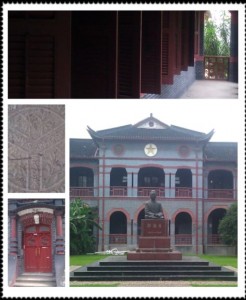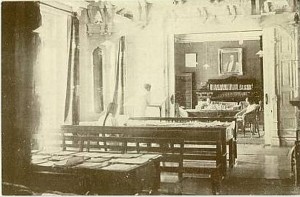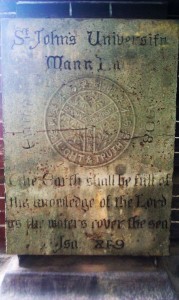
As the largest metropolis of China, Shanghai was the focus of development of modernity in China, including the development of Universities. Hidden behind Zhong Shang Park (the former Jessfield Park), in a curve of the Suzhou creek stands the old Saint John University, which used to be the most prestigious University in China. Today’s East China Institute of Politics and Law has kept most original buildings from the old times and is still a nice place for a short visit. The best way to access it is probably to walk through the park to reach its back entrance, although it is also possible to follow the Suzhou Creek.

Saint John University was created in September 1879, it was created and supported by the American Anglican Church. The picture left is from 1907, showing one of the reading room. Religion had a strong importance in the teaching, and the university was lead for decades by clergyman Dr F.L. Hawks Pott who also wrote “a short history of Shanghai“. Under his governance, Saint John College became the leading University. Teaching was in English, a lot of faculty was foreign and modern education methods as well as sport took a great place. The University was modeled after the American University system and graduate students could be join American Universities for their post graduate studies, of few of them actually going to Harvard or Yale. Saint John University also formed the elite of China’s societies with many of them becoming high civil servants or joining Chinese and international companies after graduation.

Architecture style of the university buildings have mostly been a mix of Chinese and western. They were actually often western buildings with a Chinese roof and decoration, similar to what was latter called Republican Architecture. As the University expanded, more buildings were created following the style of the time. The main building is much more of western style, quite similar to some of the buildings that were originally on the Bund, and the clock tower has been added later. Si Meng Hall near the River is also of a similar style, with all the original verandas having closed like in most old building in Shanghai. One the of really interesting one is on the right side towards the entrance. The style is clearly much later, probably late 1920’s early 1930’s as it is very similar to Jiangwan Shanghai Civic Center building. The founding stone of the Univeristy (marked 1879, picture left) is still visible. It seems to have been broken in pieces and put toghether later, probably during cultural revolution time.
Detached from the city and protected from noise by the park and the river, the campus feels like an oasis of quiet just a few minutes from busy ZhongShang Park Cross road, probably the most charming university of Shanghai.
In 1919 John Dewey visited St. John’s University on the fourth anniversary of the Day of Humiliation, a holiday marking the notorious Twenty-One Demands presented by Japan to the Chinese government. He was impressed by the deication of many Chinese students who took part in exhausting demonstrations to mark the day: prayers and a trek to and from central Shanghai in extreme heat. They would not stop, despite being ordered to do so by F.L.Hawks Potts who shut them out of the university
In 1925 some faculty and over five hundred Chinese students left St. John’s University and set up Guanghua Chinese University. I believe Guanghua was/still is in the foreign concessions.
They left St.John’s to protest the International Settlement shooting of some Chinese students who were protesting exploitation of Chinese workers in Japanese cotton mills in north Shanghai. They were also protesting the killing by the Japanese of the workers’ leader who had gone to ask for improved conditions.
I should be grateful if anyone can let me know where Guanghua University was, and probably still is, located as it featyres in my next book which goes to typeset in September. Like this blog, my books are a labour of love rather than commerce. Thank you.
I very much appreciate this informative blog. Please continue with it. For many. Old Shanghai is much more interesting than the new city.
I am so glad if some one can deliver some St.Mary’s Hall picture to me.
I was studied in there from 1947-1951, later graduated in No, 3 Girls’s school. The life in St. Mary’s was my best time I can remenbered. Ping Wang
Greetings. I attended St. John’s University from 1943-1946 and graduated with B.A. Came to USA for graduate studies and earned my M.A. and Ph.D. in the United States.
My brief biography may be searched at http://www.Google.com or http://www.baidu.com or http://www.bing.com for references.
I am the author of “A Glimpse of the Chinese Language” available at http://www.rand.org for information. I also published “Keys for Economic Understanding”Keys to Economic Understanding” and “Work and Study Cycle Theory” to be validated and implemented in USA/China to enhance productivity for economic growth.
Friday, October 21, 2011 in Maryland, USA at 12 noon.
My grandfather (Randall Norton) was a teacher and later head of the “Middle School,” what we would call the high school or prep school associated with St Johns. My mother lived on the campus. Their house was next to the Potts’ house. Her grandfather was Bishop (Graves) of Shanghai. I visited the university in 1995. I have noticed there is a new campus and wondering if there are plans to move the whole university. Does anyone know? It seems like a desirable piece of real estate, although my mother’s house and others had sunken so the ground must be soft.
Does anyone have any recollection of my uncle Ellis Tucker who taught mathematics at St. John’s in the 1930’s?
I know that Ellis Tucker was a good friend of my grandfather, J. Randall Norton, and used to stay with him in Vermont after returning from China.
Margaret Blair had asked about where the Guanghua University (Chinese spin-off of St. John’s) was located. After WWII its spacious campus was in Hongkew at Ouyang Road, at the northern tip of North Szechuen (Sichuan) Road not far from the old Hongkew Park.
Greetings: What a delight to stumble across the Shanghailander and this entry for St. John’s College. I’m writing a book about William Halsey Wood, architect for what I understand was the first pupose-built structure for the college in 1892. We’ve managed to find a few images (even some postcard views) but are coming up dry on other archival sources. We doubt seriously that any of the original documentation (correspondence, etc) might have survived but would enjoy corresponding with any of you who are familiar with the buildings.
I can be reached at plains.architecture@gmail.com
Regards,
Ron Ramsay
Hello – I was interested to read about St. John’s. I’m researching the life of Gladys Vivian Cooper whose Uncle Frederick Clement Cooper was a professor at the University. I have discovered the Library and Gym were named after him. Gladys’s father Harry Albert Cooper was Frederick’s brother. I’d like to use a paragraph and photo in my story about Gladys and hope that would be OK.
Best wishes from New Zealand.
For very one who is interested in St. John University, I uploaded two books about the university online.
seeing these books somewhere that I can’t leak to you all
https://archive.org/details/st.-johns-university-1879-1929
https://archive.org/details/a-brief-history-of-st.-johns-university-1879-1929
Hello Meg Berger, I am a historic building renovation designer in Shanghai. We have renovated the residences of Norton and other faculty members in 2023. Welcome to Shanghai to visit your grandfather and grandmother’s residences. You can contact me at that time, +8613701743914 EMAIL: 1851224646@qq.com
Hello Ellis T. Bowerfind, I know Ellis Nimmo Tucker’s story. Prof. Tucker was a great leader in mathematics in St. John’s University for all most 3o years. Prof. Tucker’s mathematics was continued by the school of mathematics science of East China Normal University.
I can be reached at jwugse@gmail.com